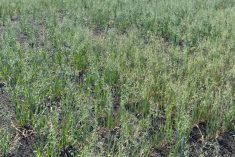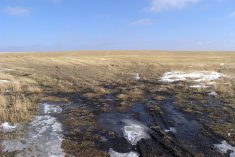MarketsFarm – After 2019’s dry growing season and messy harvest, 2020 may have fairer skies in store for producers across the Canadian Prairies.
Following the spring melt, weather in the Prairies is expected to show a bias to the drier side, which will keep excess soil moisture at bay following wet conditions last fall.
“The drying process itself may be a bit slow,” remarked Drew Lerner of World Weather Inc. in Kansas City. Springtime weather is also expected to be cooler than average, which will contribute to fields slowly drying.
Read Also

Senft to step down as CEO of Seeds Canada
Barry Senft, the founding CEO of the five-year-old Seeds Canada organization is stepping down as of January 2026.
“The outlook is not too bad, but we won’t be able to get into the fields as early as we’d like,” he said.
“Everyone is going to want it to be warmer.”
Warmer springtime temperatures may be concentrated to the Peace River region in Alberta. Lerner said that everywhere else will have a cooler bias, with periods of particularly chilly weather that will bring down average temperatures. Late instances of frost and freezes may be a cause for concern.
“We’ll be late coming out of planting season,” he predicted.
Springtime precipitation is expected to be lower than normal for the southern Prairies, and at “more normal” levels across the north.
For the growing season, however, the southern Prairies can expect more rainfall than they’ve received in recent memory.
“There’s a fair chance we’ll see a wetter tendency from June to August,” explained Lerner.
“Not exceptionally wet, but more rain than we’ve seen in the past few years.”
Alberta’s Peace River, however, may stay a bit drier than the rest of the Prairies.
“A drier year in the Slave Lake and Cold Lake area would probably be welcome,” remarked Lerner, as the area has received four years of “abundant moisture.”
“They have enough subsoil moisture that, with some timely rainfall, they’ll be just fine.”
With 2020’s growing season on the horizon, there are many factors at play that will influence Prairie weather, including ocean temperatures in the Gulf of Alaska.
“Temperatures have been unusually warm over the past couple of years, and that’s had a big role to play,” said Lerner.
“I think they’ll be cooling down a bit, but the question is, will they be normal? Will they be cooler than normal? Or are they going to warm back up? That’s what we’ll be paying attention to.”




















